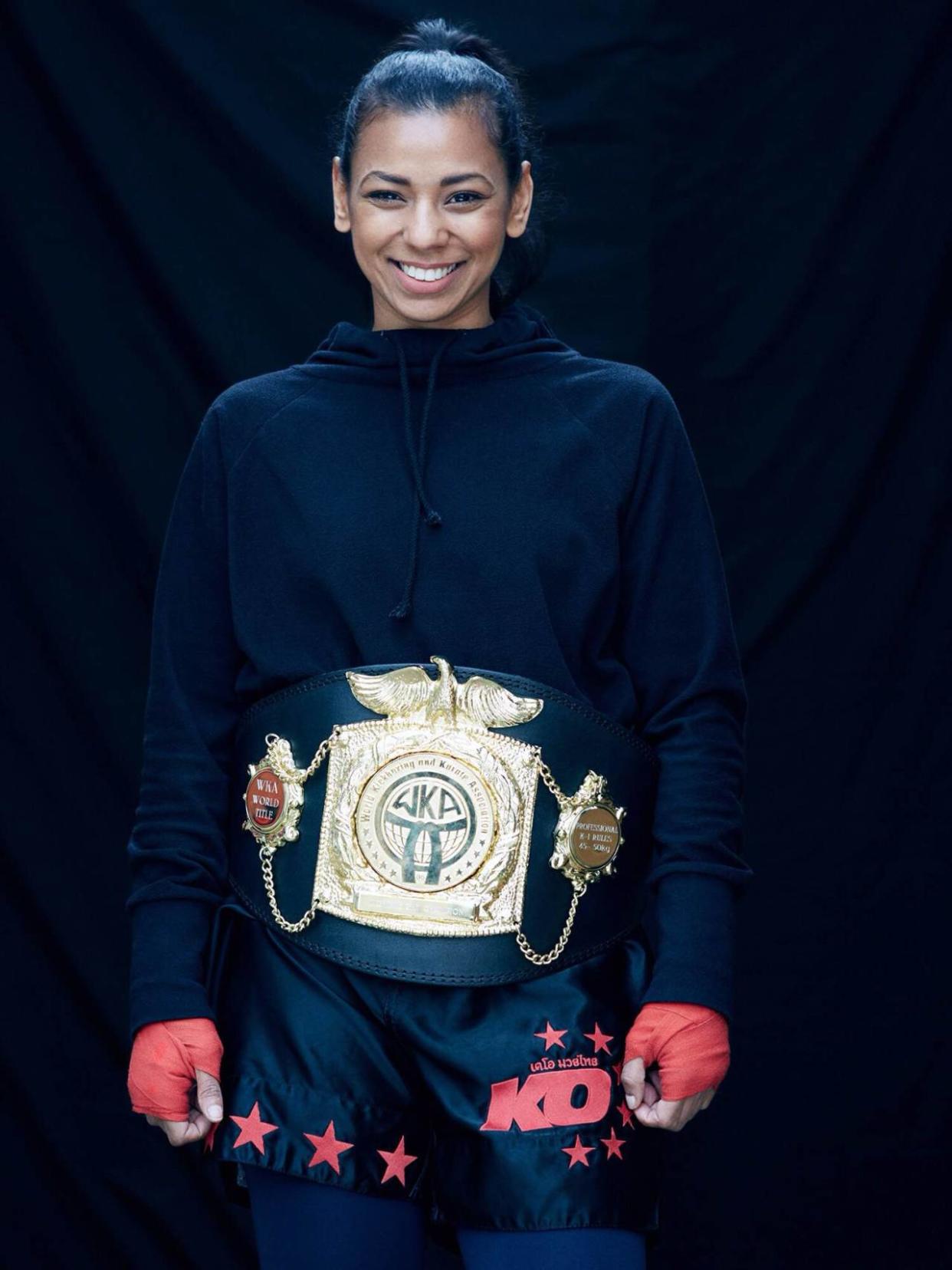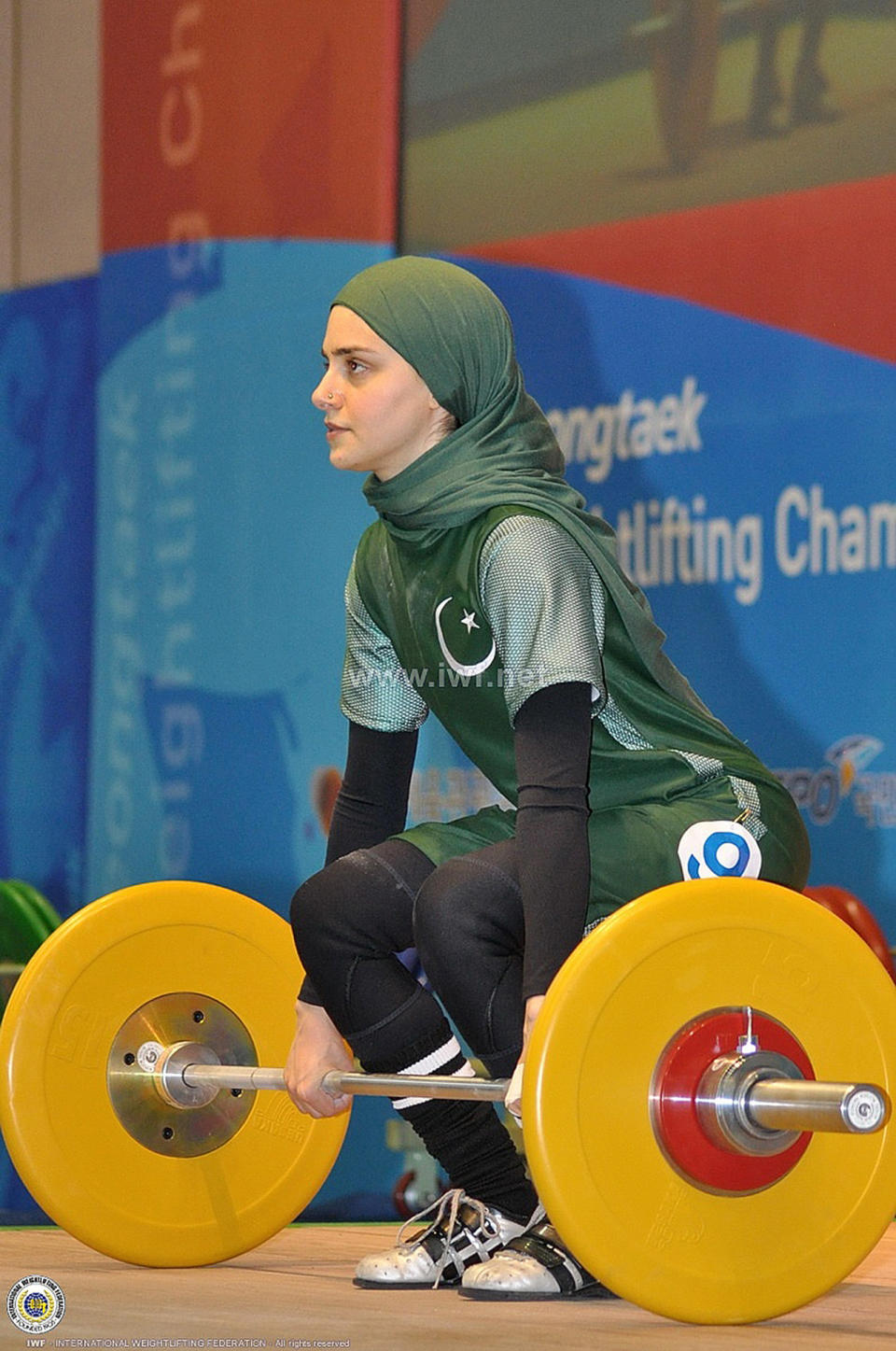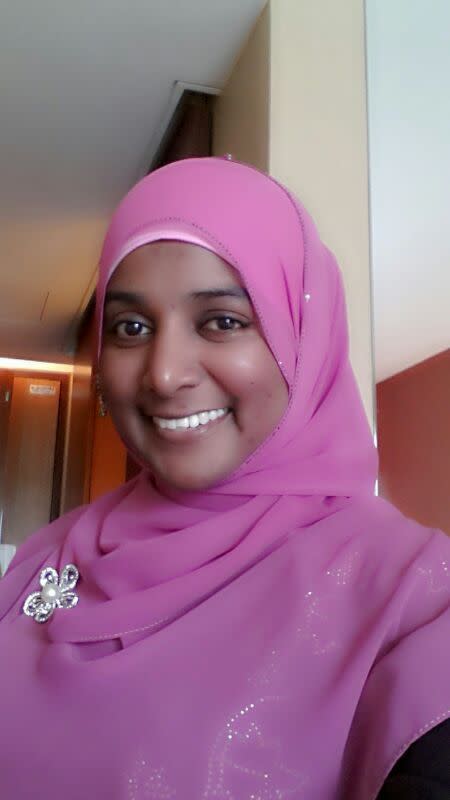Muslim Fencer Ibtihaj Muhammad and the Challenges Athletes Face Competing in Hijab

British kickboxer Ruqsana Begum doesn’t wear the hijab to perform, but she has much to say about the difficulties Muslim women athletes have with the hijab in sports. (Photo: Ruqsana Begum)
British kickboxer Ruqsana Begum does not wear a hijab when she trains or competes, but she is well aware of the challenges that the headscarf can pose for those female athletes who do.
Begum — the current British female atomweight Muay Thai boxing champion and captain of the British Muay Thai boxing team — was raised in a strict Muslim family, one that emphasized female modesty. Many young girls of Muslim backgrounds are raised in the same way, she tells Yahoo Beauty, and the hijab is an unquestionable part of their identity and their attire. (Begum herself wore the headscarf growing up.)
Unfortunately, the hijab can also prove difficult to handle when playing sport.
“The hijab takes about 10 minutes to pin up, it blows in your face, and you can’t see what you’re doing,” says Begum, who works at a school in Essex, England, where many young women wear the hijab. “It is held together by a safety pin, which is dangerous when you’re doing sport, and the worst is that when P.E. class is over, you have to walk around with a sweaty scarf all day.”
Adding to these issues are the public perception that the hijab and sports somehow don’t go together; the longstanding ban on headscarves several sport regulatory bodies have imposed (FIFA, for example, only lifted its restriction in 2014), and the terrorist attacks that have increased Islamophobia the world over, leaving many Muslims feeling scrutinized and stigmatized.

U.S. fencing Olympian Ibtihaj Muhammad (Photo: Reuters)
Nevertheless, female Muslim athletes, professional and otherwise, are hopeful change is coming. Many are looking at the American fencer Ibtihaj Muhammad as a beacon of that change.
Muhammad, who is ranked second in the United States and twelfth in the world, will be the first woman ever to compete at the Olympic Games in hijab. Her mother reportedly urged her to take up fencing because the sport met the family’s requirements with respect to clothing and modesty. (Muhammad had played many other sports, but gave them all up because the uniforms did not accommodate her religious beliefs.)
Fortunately, she excelled at it — just as Kulsoom Abdullah, a world-champion weightlifter, has thrived in her chosen sport.

Kulsoom Abdullah at the 2012 Asian Weightlifting Championships in South Korea, where she represented Pakistan. Photo: International Weightlifting Federation
Abdullah first took up taekwondo when she was in graduate school (“The instructor was accommodating in my choice of clothing — headscarf and covered arms and legs,” she tells Yahoo Beauty), but weightlifting quickly became both an important part of her physical routine and a hobby. Within a year, her coaches persuaded her to compete locally, and soon after, she was able to qualify for the 48-kilo weight class at the 2010 USA Weightlifting National Championships.
“I was told I would have to compete in a customary singlet, where my legs, arms, and head would be uncovered, so I chose not to take part.” Abdullah says. “It was very demoralizing — it affected my training and well-being. I was used to dealing with prejudice and exclusion, but I had been having fun at open competitions where I could dress as I saw fit. To be suddenly told that you can’t participate because of your clothes was heartbreaking.”
A top practitioner of taekwondo in France, who spoke to Yahoo Beauty on condition of anonymity, said that she is told to remove her hijab at every competition she takes part in.
“When I look around the world and I see that there women athletes competing at professional athletic events in hijab, I don’t understand why it isn’t allowed in France,” she says. “It’s particularly disturbing because women who wear headscarves here are perceived as being backward and conservative, so if authorities ban the hijab at professional sporting events, that excludes and isolates these women even more. This is a huge problem in France.”
Family pressures
Exclusion at large sporting competitions aside, Begum believes many Muslim girls and women from strict families, lacking family support for their athletic activities, are deterred from participating in sports.
“I had always enjoyed sports, but I faced many limitations growing up,” she says. “My younger siblings could ride their cycles and play cricket, but because I was the oldest daughter, I was not even allowed to go outside and play.”

Shabnam Mokhtar, a martial art expert, fought to be able to compete in hijab. (Photo: Shabnam Mokhtar)
For Shabnam Mokhtar, a gold medal-winning practitioner of Silat (a martial art form from Malaysia and Indonesia), sports was not an option growing up. Her father totally forbade it, she tells Yahoo Beauty, telling a handball coach to remove Mokhtar from the team she played on as a teenager. To continue playing, she had to enlist her mother to champion her cause.
“I’m very stubborn — I don’t give up easily. I’ll always go to my mom, convince her, and prove to her I’m not doing bad things, and she’ll allow me to continue sports,” Mokhtar says. “My mom knows I am passionate — she cheers for me at domestic games. She knows I’m a wild horse, so she might as well work with me rather than constrain me.”
For years, Begum kickboxed in secret, coming up with all manner of excuses for the busted lips, cuts, and bruises that are part and parcel of the sport, and only disclosing her kickboxing to her parents when she reached a level of excellence for which the only outlet was professional competition.
“They were better with it than I expected, especially when they saw how safe the gym environment was and how passionate I am about it,” she says. “But even now, they have not said that they approve or disapprove, they wouldn’t come and watch me fight, and I would never want them to have to see me in my training attire.”
Creating trust
Being motivated to take part in sports and becoming confident enough to pursue a sport is no easy feat for the best of us, and many girls and women of strict Muslim backgrounds can lose all motivation given the issues they face, says Abdullah, who made history when she became the first woman to lift completely covered after the International Weightlifting Federation (IWF) modified its rules in response to her request.
She feels it is important to create safe, comfortable environments for Muslim women, particularly those from orthodox families who wear the hijab, to participate in sports, fostering the idea of sports as something not only important for health and well-being but accessible to all.
“Maybe if religious organizations supported sports, held intra-murals, provided classes and instruction, that would help,” she says. “It would also help if religious leaders speak about this issue and how being athletic is something that’s actually encouraged in the religion.”
Greater acceptance of the hijab in international sports will also help more girls and young women from Muslim families pursue athletics, because it will show them “they don’t have to sacrifice their religion to continue their passion,” Mokhtar says.
Mohktar is from Malaysia, where the majority of the population is Muslim and where the hijab is common, but she believes that anywhere in the world, “If a teacher or a coach sees potential in a girl with a hijab, they must encourage her, because a caring and trustworthy coach or teacher can make a lot of difference to a family and can help convince them that their daughter will not be required to take off her hijab to be active in sports.”
As more sport regulatory boards change their clothing rules and as more athletes like Muhammad and Saudi-American Olympic sprinter Sarah Attar (who ran in the 2012 Olympics) compete in premier sporting events, what’s needed is a greater realization at the global level that “the hijab is a choice and it is not forced on Muslim women,” Mokhtar says. “And if a female athlete wears a hijab, it’s important for people to understand that she is still an athlete, and that the hijab does not change her or her passion for her sport.”
Sports hijab: A practical solution?

Will the sports hijab movement open more doors for Muslim women in sports? (Photo: Bahareh Hosseini)
In the years she has been lifting, Abdullah has been forced to come up with creative solutions to the logistical problems her hijab poses. She still wears the traditional scarf, which is pinned in back but requires adjusting between reps to ensure that it sits tight. She is adept at this, of course, “but for weightlifting, I can’t have excess fabric on my neck and chest, because the barbell could get caught on it, or the fabric fly up and cover my face,” she says.
In Malaysia, “slip-on” hijabs made of lightweight, cooling fabrics are already the norm, says Mokhtar, who has been using them for a while now to work out.
“I can jump, lift weights, sprint comfortably,” she says. “I go to the gym in the U.S. [when traveling for business] and do kettle bell and medicine ball exercises, and I have never had people say anything negative to me.”
Begum has been a keen proponent of the sports hijab. After much research into figuring out the right lightweight, breathable fabric, and comfortable yet secure fit, she is getting ready to launch her own brand.
“I think a sports hijab can make a huge difference to many females who want to be in a sport, feel comfortable, and not like they are being judged,” she says. “With a sports hijab, a Muslim woman can feel like she is appropriately dressed and not compromising on her beliefs or those of her family. I think it can encourage more women to come forward and participate in sports and not believe that sports is off-limits for them.”
Let’s keep in touch! Follow Yahoo Beauty on Facebook, Twitter, Instagram, and Pinterest.
